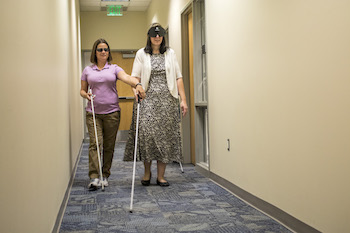- Blind and Visually Impaired
-
Policy and Laws

Laws Protecting the Blind
41-6a-1007. Operators to yield right-of-way to blind pedestrian – Duties of blind pedestrian – Use of cane-
Failure to yield – Liability.
The operator of a vehicle shall yield the right-of-way to a blind or visually impaired pedestrian carrying a clearly visible white cane; or accompanied by a guide dog specially trained for the purpose and equipped with a harness.
Except as provided in Subsection (1)(b)(ii), a person who fails to yield the right-of-way is liable for any loss or damage which results as a proximate cause of the failure to yield the right-of-way to blind or visually impaired persons.
Blind or visually impaired persons shall:
- exercise due care in approaching and crossing roadways; and
- yield the right-of-way to authorize emergency vehicles giving an audible warning signal.
A pedestrian other than a blind or visually impaired person may not carry a cane as described in Subsection (1).
Penalty:
41-6a-202. Violations of chapter – Penalties.
A violation of any provision of this chapter is a class C misdemeanor, unless otherwise provided.From the Driver’s Manual:
You must yield the right-of-way to any pedestrian using a guide dog or carrying a white cane. Only blind or nearly blind persons are permitted to carry white canes.Title 53A State System of Public Education
Chapter 25a Blind Persons’ Literacy Rights and Education Act
53A-25a-104. Instruction in reading and writing of Braille.Instruction in the reading and writing of Braille shall be sufficient to enable each blind student to communicate effectively and efficiently with the same level of proficiency expected of the student’s peers of comparable ability and grade level.
The student’s Individual Education Plan (IEP) shall specify:
- The results obtained from the skills assessment required under Section 53A-25a-103;
- the manner in which Braille is to be implemented as a reading mode for learning in other academic activities;
- the date on which the Braille instruction shall begin;
- the length of the period of instruction and the frequency and duration of each instructional session;
- the projected level of competency in the reading and writing of Braille to be achieved by the end of the IEP period and the objective assessment measures to be used; and
- if a decision has been made under Section 53A-25a-103 that Braille instruction or use is not required for the student: a statement of the reasons for choosing another reading mode.
The Randolph-Sheppard Act
In 1936, The Randolph-Sheppard Act was signed into law. It was designed to foster independence and self-sufficiency by enhancing employment opportunities to eligible Vocational Rehabilitation clients who are blind or visually impaired. This program trains, licenses and provides business support in the area of self-employment by operating cafeterias and vending machines on government property.